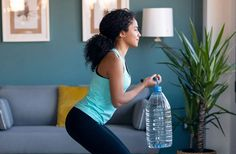Getting fit at home has never been more accessible or more creative. In 2025, with busy schedules and rising gym costs, many fitness enthusiasts are turning to everyday household items for workouts to stay in shape.
Whether you’re short on equipment or just want to add some fun variety to your routine, the solution might be right in your kitchen or living room.
This guide uncovers five smart, effective, and totally doable ways to transform common items into powerful workout tools. Get ready to rethink your space and start building strength, stamina, and flexibility without ever stepping foot in a gym.
What Are The Top 5 Ways to Use Household Items for Effective Workouts?

1-Water Jugs as Dumbbells
If you don’t own dumbbells, a filled water jug can be the perfect replacement. One-gallon jugs, when filled, weigh around 8 pounds (3.6 kg), making them ideal for bicep curls, shoulder presses, or even weighted squats.
You can adjust the amount of water inside based on your strength level, which gives you flexibility. Holding one in each hand lets you train both sides of your body evenly, just like traditional dumbbells.
This household hack is cost-effective and space-saving, great for small home gyms. For added grip, wrap a towel around the handle. This method offers a great way to stay strong without buying new equipment. Want a full month of home workouts with items like this? Try the 30-Day Home Workout Challenge and get creative daily.
2-Chairs for Step-Ups and Dips: Boost Cardio and Strength
Chairs are great household items for workouts, they’re fantastic tools for full-body workouts at home. By using a sturdy chair, you can easily perform step-ups, which target your glutes, hamstrings, and quads, helping to elevate your heart rate and improve cardio endurance.
Meanwhile, tricep dips work wonders for building upper body strength, especially in your arms and shoulders.According to ACE Fitness, body-weight exercises like these are highly effective for developing functional fitness and can be scaled to suit any level.
Make sure the chair is stable, placed on a flat surface, and free of wheels to avoid accidents. Whether you’re doing fast-paced reps for cardio or slow, controlled movements for strength, this simple setup turns any room into a mini gym.
3-Backpack Filled with Books: Resistance for Squats and Lunges
Transform your backpack into a powerful resistance tool by filling it with books or heavy items you already have at home.
Wearing it while performing squats and lunges adds extra weight, effectively increasing the intensity of these classic lower-body exercises. This method is perfect for building leg strength, improving balance, and enhancing core engagement, all without needing expensive gym equipment.
According to the Mayo Clinic, adding resistance to body-weight movements is key for muscle development and bone health. Just be sure the weight is evenly distributed in the backpack and that the straps are secure.
4-Towels for Sliders: Core and Stability Workouts
Using towels as sliders is a simple yet powerful way to target your core and improve stability at home. Just place small towels under your feet on a smooth surface like tile or hardwood.
Then, perform moves like mountain climbers, plank jacks, or reverse lunges to engage multiple muscle groups. These sliding exercises boost your balance, build core strength, and require no expensive gear.
According to ACE Fitness, slider workouts are highly effective for functional movement and injury prevention. So next time you’re short on equipment, grab a pair of towels and turn your living room into a stability-boosting fitness zone.
5-Stairs for Cardio and Lower Body Strength
Stairs are one of the most underrated tools for home workouts, offering a free and effective way to boost cardiovascular health and strengthen the lower body. By simply using the stairs in your home or apartment building, you can perform high-intensity interval training (HIIT) that burns fat and builds endurance.
A great starter workout is doing 5 rounds of running up 10 steps and walking back down to recover. This not only improves heart health but also targets your calves, glutes, quads, and hamstrings.
You can also incorporate bodyweight moves like calf raises, stair lunges, or step-ups for added variety. According to the American Council on Exercise (ACE), stair workouts enhance both strength and aerobic fitness, making them a smart choice for any at-home routine.
How to Stay Safe and Effective with Household Workouts?

To get the most out of your household fitness routines, it’s crucial to prioritize safety and effectiveness. Before starting any safe DIY workouts in 2025, always inspect the items you plan to use, whether it’s a chair, towel, or backpack, for stability and durability.
Avoid slippery surfaces, make sure weights (like water jugs or books) are evenly distributed, and start with lower reps to gauge how your body responds. For more effective household fitness tips, combine these tools with body-weight exercises like squats, push-ups, or planks to create a balanced, full-body workout.
I recommend warming up properly and using correct form to prevent injuries while maximizing results. According to Harvard Health Publishing, even simple household movements can yield excellent fitness benefits when performed consistently and mindfully.
Conclusion
In 2025, staying fit at home is easier than ever. By turning common household items into workout equipment, you can build strength, improve cardio, and boost flexibility without spending a dime.
From using water jugs as dumbbells to running upstairs for heart-pumping cardio, these clever tricks make fitness accessible and fun.
Plus, they fit perfectly into small spaces and busy schedules. With a little imagination and consistency, your home can become the ultimate gym. So why wait? Start turning your everyday tools into powerful fitness allies today.







